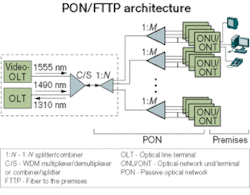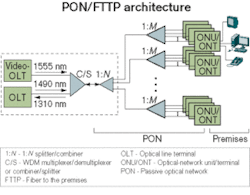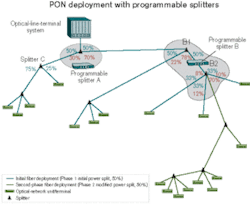Dynamic power distribution in PON/FTTP networks
The convergence of voice, data, and video services as well as the insatiable appetite of customers for bandwidth places a burden on the access network to deliver high data rates in a cost-effective manner. Passive optical networks (PONs) and fiber to the premises (FTTP) technologies hold the highest promise for such networks. These point-to-multipoint fiber-based architectures are capable of delivering high traffic rates through single or multiple channels, while amortizing the cost of the infrastructure over a large number of consumers.
PON/FTTP deployment is partly fueled by the industry's adoption of specifications developed by major standards bodies. The International Telecommunication Union ITU-T Recommendation G.983 created the foundation for ATM- and Ethernet-based PONs (APON and EPON, respectively), while G.984 paved the way for supporting gigabit traffic (GPON). Alcatel, Fujitsu, and Nortel Networks are currently the leading suppliers of PON technology, with many smaller companies attempting to enter this potentially lucrative market.
Indeed, PON revenues grew 240% last year, according to Infonetics Research, which expects revenue growth to continue to accelerate in the coming years. Asia-Pacific countries such as Japan, China, and Korea lead the market. Sweden and the Netherlands lead in European deployments. The United States is well behind these countries in deployments, but incumbents BellSouth, SBC, and Verizon have all announced plans to deploy FTTP networks.
While PON/FTTH technology promises an attractive method for delivering high bandwidth within the access network, initial deployment costs are high, partly because the use of static splitters, which control the distribution of optical power from the central office (CO) and local distribution sites, requires layout of the entire fiber plant before any revenues materialize. However, a new breed of splitters based on planar-lightwave-circuit (PLC) technology can provide carriers with the flexible network topology necessary for incremental network build-out, without the traffic disruption that accompanies the replacement of static splitters. These so-called "programmable" splitters enable operators to meet changing network needs by dynamically adjusting—remotely from a centralized management station—the split ratios of optical power throughout the point-to-multipoint distribution network.
PON/FTTP uses optical point-to-multipoint network architecture to connect customer premises to the backbone. WDM is used to deliver data, video, and voice services from a CO to the customers and upload data. Customers share downstream traffic, while individual upstream traffic is combined and transmitted to the CO.
In the PON/FTTP architecture in Figure 1, the optical line terminal (OLT) and the video-OLT are the connection points between the access network and the data- or video-backbone network, respectively. They are responsible for converting signals from the electrical to optical domain (and vice versa), flow control, and path management. A WDM combiner/splitter is used to combine data, voice, and video downstream traffic and extract upstream data traffic. Downstream video traffic uses 1,550–1,560-nm wavelengths, while data traffic uses 1,490-nm downstream and 1,310-nm upstream.The point-to-multipoint optical distribution network (ODN) typically uses a tree topology, with optical 1:N splitters and singlemode fiber links. Passive splitters are preferred for cost, simplicity, and reliability reasons. To increase cost-effectiveness, carriers try to maximize the network fanout or alternatively extend the reach of the fiber links. Typically, a 1:4 or 1:8 splitter is used at the root (at the CO) and 1:16 or 1:32 device is used at local distribution sites.
The optical-network terminal or optical-network unit (ONU) resides at the premises and terminates an individual optical link. It receives and distributes downstream traffic and transmits data upstream. As in the case of the OLT, it provides WDM multiplexing and demultiplexing.
Traditional ODNs use static splitters because of their resilience. Passive components are highly reliable and not affected by power failures.
However, the use of static splitters dictates a fixed network topology. The entire fiber plant and associated splitters must be planned and deployed in advance, taking into account geographical customer distribution and power budgets. Lack of flexibility and scalability presents several major problems for service providers.
Demographic changes and fluctuating demand make it impossible to precisely identify the network topology.
As a result, carriers must build-out their network in advance to accommodate maximum capacity, and though the cost of PON components is continuously being driven down, the cost of laying fiber is still high. Accordingly, operators are incurring high initial deployment cost before any revenues materialize, thereby introducing great financial risks. Additionally, expansions due to new construction or increased demand are very hard to implement. Such changes require the replacement of existing splitters, causing temporary connectivity outages within the entire network. Therefore, service provisioning to new areas is slow and impacts the service of existing customers.
Fortunately, programmable splitters provide carriers with the flexible PON topology necessary for incremental network build-out. By placing these systems in strategic locations within the network, such as the CO or regional distribution centers, carriers can modify the power distribution between various branches to meet changing requirements. Such reconfiguration is necessary when new users are added to an existing branch, when new branches are added, or when the reach of a network segment is extended. Adjustment of the optical power distribution can be done remotely from a centralized management station and without the traffic disruption that would otherwise accompany the replacement of static splitters. Using programmable splitters to scale their networks, carriers can minimize their up-front cost and "pay as they grow." Programmable splitters can also reduce stocking requirements for various split-ratio optical splitters.
As the following example demonstrates, by reconfiguring the programmable splitters, network operators are able to expand their PONs while maintaining network connectivity during the upgrade. In the two-phase PON deployment illustrated in Figure 2, the initial phase consists of a balanced tree topology. There are two main branches with roughly equal optical power requirements. Programmable splitter A is configured for a 50-50 split ratio. Similarly, programmable splitters B1 and B2 are configured for even power distribution. Splitter C feeds a single ONU on one branch and three ONUs on another. The branch with a single ONU requires 25% of the optical power, while the other branch receives 75%.During the second phase, the right branch of the PON is extended at point B2. A new branch is added, linking to eight new nodes located at a greater distance. The addition of the new branch requires revised split configurations of all the splitters on the path leading from the OLT to point B2 (A, B1, and B2). To accommodate heavier signal power consumption on the right branch, programmable splitter A is configured for a 30-70 split ratio. Splitter B1 allocates more power to the branch leading to B2 (78% versus 22% on the other branch). Taking the number of nodes and their distance from splitter B2, it is configured for an 8–12–70–10 1:4 split ratio, allocating 70% of the power to the new branch.
Programmable splitters are based on PLC technology and take advantage of the PLC's unique ability to multicast optical signals. Aside from its ability to switch paths, this optical-switching technology can connect a single ingress port to multiple egress streams. Furthermore, leading PLC products support weighted multicasting, where power can be split at any ratio. Programmable splitters support soft configuration of the weighted multicast to meet any deployment needs, and tuning of the split ratio is highly accurate using fine resolution.
A characteristic of solid-state optical-switching technology, high reliability provides resilience similar to that offered by passive products. Moreover, a power-off default configuration allows programmable splitters to carry traffic during power failure in a similar way to their passive counterparts.
PON/FTTH technology has long been a promising means for delivering high bandwidth within the access network, provided it was cost-competitive. With highly resilient PLC-based programmable splitters, this promise can now come true. Carriers today can build their fiber plants incrementally to minimize up-front costs and risk and upgrade their networks smoothly, without any traffic outages.
Abe Queller is vice president of applications engineering at Lynx Photonic Networks (Calabasas Hills, CA). He can be reached at [email protected].


